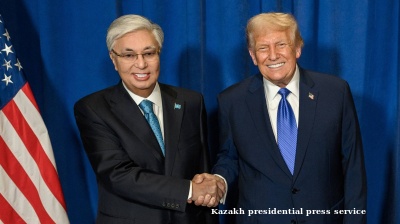Kazakhstan’s economy, estimated to be $260bn last year, is the largest in the Eurasia region (ex-Russia). President Kassym-Jomart Tokayev has set out a very ambitious reform programme to double that figure by the end of this decade. To achieve this, Tokayev has set out several reform priorities aimed at making the country a more attractive destination for investors and which will help deliver on the income and social improvement promises he has made to the Kazakh people. One of his key mandates is to bring an end to the extreme income inequality and the crony capitalism which his predecessor, Nursultan Nazarbayev, let flourish under his presidency, from independence in 1991 to his resignation in 2019.
Part of the reform agenda involves making current budget spending more effective and the state bureaucracy more supportive of the business community and investors. The National Investment Digital Platform has been set up specifically to help manage, monitor and track investment projects across the country. Other mechanisms have been put in place to allow investors to highlight problems and to obtain senior government help to resolve issues quickly.
Another of his major initiatives is to reduce the incidence of corruption and old-school crony capitalism. Tokayev appointed Oljas Bektenov as Prime Minister in February of this year with a clear mandate to reduce corruption. Bektenov previously headed the anti-corruption agency for two years before this appointment. There is already evidence of positive progress. The Council of Europe’s Group of States against Corruption (GRECO) published its first report evaluating Kazakhstan's progress very positively, albeit with plenty to do still. In the annual Transparency International Corruption Perception Index, Kazakhstan most recently ranked 93rd (out of a 180 countries), an improvement from 124th in 2018, the year before Tokayev becoming president. Further improvement is expected this year.
Boosting incomes and the importance of the consumer and service sectors is also high on the president’s list of priorities. GDP per capita, in nominal terms, is estimated at $14,400 for this year, while the World Bank’s estimate, based on purchasing power parity (PPP), is $35,500 and shows the considerable growth potential in the economy. The population, now estimated at 20mn, is relatively small for what is geographically the world’s ninth-largest country but consumer spending grew to over $120bn last year.
The strong growth in incomes, and the dispersal of the population across such a vast territory, is one factor why there has already been fast growth in the e-commerce and fintech sectors and why developing the financial services sector is one of the priorities for the government. There has also been a history, under the previous regime, of poor bank sector supervision that led to the state spending billions of dollars in bailouts. Much tighter regulatory oversight, including strict compliance with Western financial transaction sanctions against neighbouring Russia, are in place and are viewed by the government as not only good economic management but critical for Kazakhstan’s position in the global economy and supporting the President’s declared neutral-vector stance in geopolitics.
There are three financial sector regulators in Kazakhstan: the AFR, which is responsible for the regulation of banks, branches of foreign banks, banking organisations, MFOs, insurance organisations, pension funds and securities market subjects; the National Bank of Kazakhstan (NBK), which is the central bank of Kazakhstan and is responsible for monetary policy, stability of financial and systems, currency control and regulation, and regulation of payment systems, payment system operators and payment organisations; and the Astana Financial Services Authority (AFSA), which regulates financial and payment services provided within the Astana International Financial Centre (AIFC) framework, namely the financial and payment services provided by AIFC entities to other AIFC entities.
All three have been given much greater regulatory oversight in recent years as the government aims to have the entire financial system and digital ecosystem operate and develop in compliance with best international practices.
Fintech companies are becoming key players in the financial services market. The sector has expanded fourfold in the last six years, with the number of fintech startups increasing from about 50 in 2018 to 200 in 2024, according to a joint report by RISE Research, the National Payment Corporation of Kazakhstan, Mastercard and Tarlan Payments. This growth was fuelled by the absence of efficient legacy banking systems, allowing major banks to swiftly adopt new technologies and invest in payment infrastructure to improve service efficiency and reliability.
By 2021, 81% of Kazakhstan’s population had access to banking services, and by 2024, 92% had internet access, with 86% of all transactions conducted digitally. Cashless transactions have seen a significant rise, with 77.4mn payment cards in circulation as of June 1. The monetary volume of transactions using payment cards reached KZT15.4 trillion ($32.5bn) from 1.1bn transactions in May 2024. Non-cash transactions increased by 13.3% compared to the same period in 2023, reaching a volume of KZT13.3 trillion ($28bn).
The potential for growth is not just in fintech. For example, over the last five years, the share of e-commerce in total retail trade has risen seven times, from 1.8% in 2019 to current 12.7% recorded last year. Despite the strong growth, the penetration rate of e-commerce in Kazakhstan is 2-3 times lower compared to developed markets. This indicates a great growth potential for all players in the market. At the beginning of 2024 the Kazakh government announced a target to increase the share of e-commerce to 20% by 2030, noting the growing importance of the sector in global trade. However, to date, all initiatives to expand the sector have come from the private sector and there are no reasons to assume that this will change.
Marketplaces are expected to be among key growth driving factors for the e-commerce sector development, as the market is scaling up rapidly. This development was facilitated by the introduction of high quality and easy to use products and apps by, for example, Kaspi.Kz (by far the dominant player in the digital economy, while Halyk Bank is the main player in traditional banking) and other companies in the private sector. Additionally, the introduction of buy now, pay later (BNPL) services, microcredit products and attractive grace period conditions contributed to the development of the sector. The significant influx of investments in warehouse and transport logistics served as the basis for the rapid development of local and international marketplaces.
Kazakhstan's development of the Digital Tenge represents a significant stride towards a digital economy, facilitating payments and transactions through pilot phases with second-tier banks and initiatives like digital vouchers and stablecoin frameworks. This initiative aims to modernise financial infrastructure and promote financial inclusion.
Additionally, the integration of digital assets through AIFC (Astana International Financial Centre) crypto exchanges and the development of Open Banking and Open API frameworks highlight Kazakhstan's commitment to fostering innovation and competition within its financial sector. These initiatives enable personalised financial services and facilitate broader financial ecosystem integration. Such systems will also assume much greater importance in the coming years as the expanding BRICS group of countries continues to move towards a cross-border trade settlement system based on digital currencies.
One additional factor which the Kazakh government and regulators are paying very close attention to is the risk of accusations that the financial sector is helping Russians or Russian trade to side-step Western sanctions. Clearly this is a very serious issue, especially as the US Treasury Department tightened such regulations and introduced secondary sanctions threats earlier this year. Kazakhstan has joined other countries with strong trade relations with Russia, including China, Turkey and the United Arab Emirates, in strictly abiding by the US regulations. It means that all Kazakh financial institutions are closely monitored to ensure they use best-practice KYC (know your customer) and avoid any transaction which is unclear. The National Bank of Kazakhstan has allowed (as have other central banks in Central Asia) officials from the US Treasury to be physically based in the NBK in Astana to monitor the enforcement of these regulations.
After spending longer in the preparation phase than expected, Tokayev’s reform programme is now starting to pick up pace. He will certainly face more challenges, such as the delicate balancing of trade with Russia with Western sanctions compliance and the fact that the economy is still very reliant on the oil sector (60% of exports). But at least today there are much better management and regulatory systems and procedures in place than has ever been the case in Kazakhstan. The digital economy is already playing a major part in the growth and improvement story, while continued innovation and income growth will ensure that strong sector growth continues.
Tech

Russia blocking messaging apps again, sets up copycat Telegram app
Russia’s internet watchdog Roskomnadzor has been blamed for another round of internet outages in Russia, as the state sets up a Telegram messaging app clone as the Kremlin continues to take increasing control of RuNet.

Albania’s AI minister ‘pregnant’ with 83 children, PM says
AI “minister” Diella will give birth to dozens of digital parliamentary assistants for ruling party MPs.

Is Kazakhstan building a digital utopia, or a China-style surveillance state?
Many Kazakhs will tell you that officials should limit their ambitions to fixing the internet speed. Others worry that the time for joking is over.

Kia inaugurates $310mn "highly automated" automotive plant in Kazakhstan
Featuring 68 industrial robots, the plant is designed to produce up to 70,000 vehicles annually.



